The #1 Best Exercise for Leg Pain, Says Science
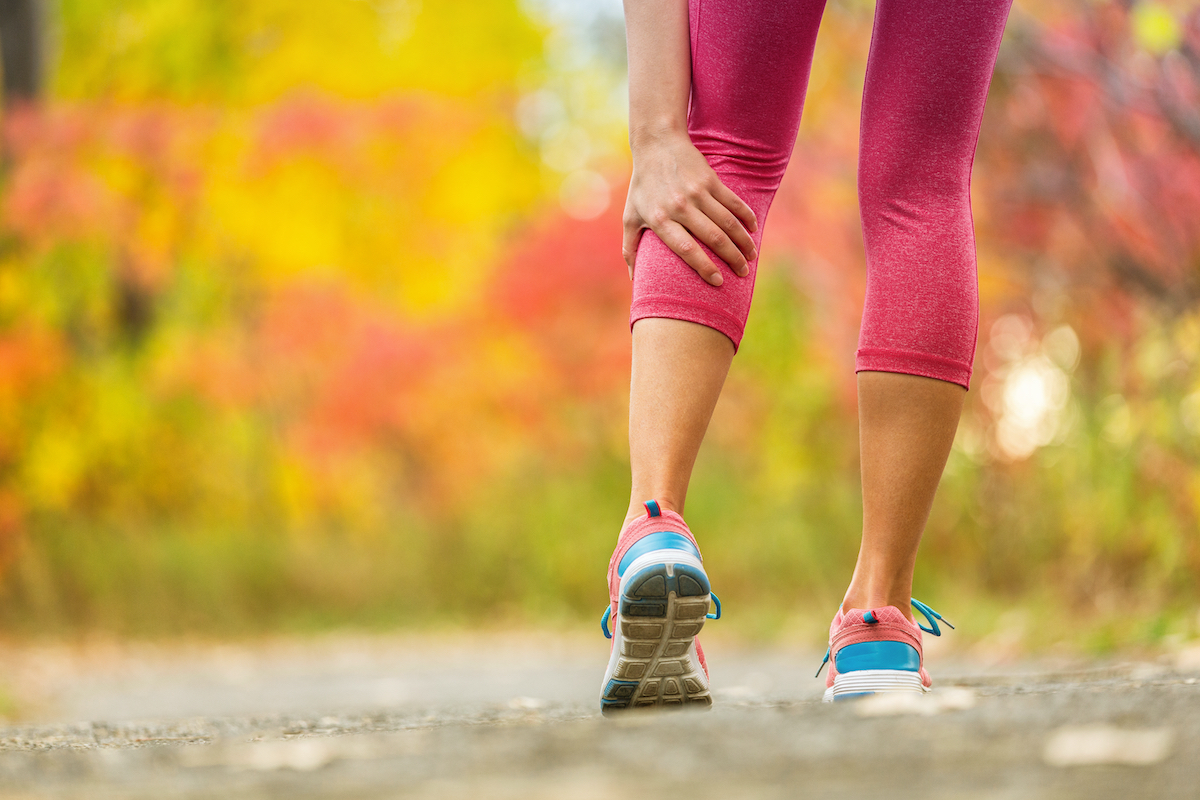
The occasional ache or pain is inevitable as we grow older, but you may be surprised to learn just how common constant, chronic pain is among Americans. Recent research published in the scientific journal Pain reports one in five U.S. adults live day in and day out with a form of chronic torment. “Chronic pain is a serious condition that affects millions of Americans,” says corresponding study author R. Jason Yong, MD, MBA, medical director of the Pain Management Center at the Brigham and Women’s Hospital.
Chronic pain can come in a variety of forms, but one of the most prevalent is osteoarthritis. Per the CDC, osteoarthritis is the most common variety of arthritis, affecting over 32 million Americans. Caused by the gradual wear and tear, or grinding down, of the cartilage within joints, this condition is known to cause constant aches and pains, stiffness, and a gradual loss of overall flexibility and functioning.
Osteoarthritis is notorious for impacting the legs, and more specifically, the knees and hips. Leg discomfort caused by osteoarthritis can make the simplest of daily tasks feel like a pain tolerance exam. And, while many people’s first reaction may be to land on the nearest sofa, that’s actually the wrong move entirely. “Inactivity makes knee osteoarthritis worse,” Dr. Kari Orlandi, DPT, told The Cleveland Clinic. “As soon as you stop moving, the joint becomes stiffer and stiffer. Think of it like this: Motion is lotion.”
So what’s the #1 best exercise to help manage and alleviate osteoarthritis-associated leg pain? Keep reading to find out. And next, don’t miss These Walking Workouts Burn Fat Fast, Trainer Says.
The best exercise for leg pain is swimming!
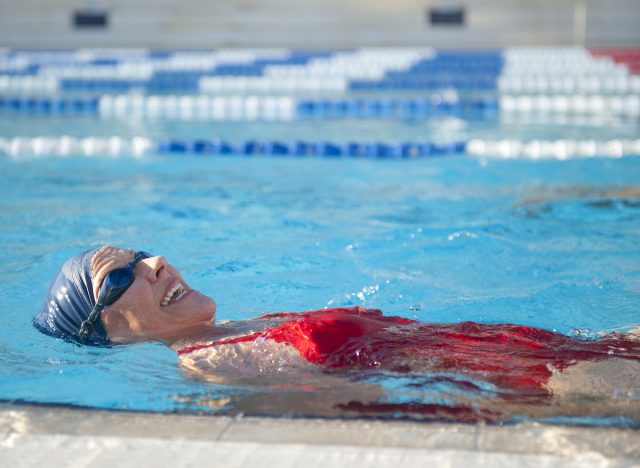
The human body is roughly 60% water, so perhaps it shouldn’t be all that surprising that taking up swimming offers a litany of health benefits. Plenty of research tells us that swimming is the ideal option when it comes to exercising for osteoarthritis pain relief. This study, published in Rehabilitation Nursing, reports that an aquatic exercise/swimming program helped a group of adults living with osteoarthritis relieve pain symptoms, regain a portion of flexibility/functioning, reduce stiffness, and carry out daily tasks more easily. Even better, participants reported generally feeling more positive and upbeat about their condition in general.
Another study, this one released in Interventional Medicine and Applied Science, focused specifically on knee osteoarthritis and tracked pain outcomes among a group of older men. Half of the study’s participants engaged in regular aquatic exercise for two months while the other half did not. Those assigned to the swimming group reported significant leg pain relief and improved balance by the end of the eight-week period.
An additional research project released in the Journal of Rheumatology came to similar conclusions. Study authors found that “regular swimming exercise reduced joint pain and stiffness associated with OA (osteoarthritis) and improved muscle strength and functional capacity in middle-aged and older adults with OA.”
Related: Sign up for our newsletter for the latest Mind + Body news!
Swimming eliminates stress on your leg joints
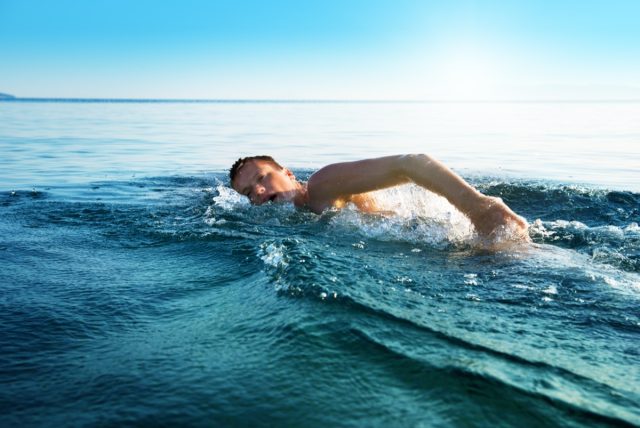
Why is swimming a cut above the rest when it comes to subduing leg pain? Aquatic movements are much easier on the joints and bones than land-based exercises. When you go for a run outside, each time your feet meet the ground it places a certain amount of stress on your joints and cartilage. This may exasperate and worsen osteoarthritis symptoms and related pain.
Swimming, on the other hand, is much easier on the body due to the buoyancy of water. Swimming represents a one-two punch in the fight against osteoarthritis and leg pain. A dip in a pool allows you to get in the motion, strength-building, and blood circulation you need to reduce stiffness and improve flexibility, all while placing virtually no additional pressure on the joints and cartilage.
Moreover, you don’t necessarily have to swim laps to reap these leg pain-relieving benefits. Any type of aquatic exercise will be a welcome respite for aching joints. “It doesn’t just have to be swimming,” Dr. Van Iterson, Ph.D., MS, explained to The Cleveland Clinic. “You can take a water aerobics class or water walking in both shallow and deep-water.”
Related: Secret Tricks for Getting a Lean Body After 40, Science Says
Swimming at any age has its benefits
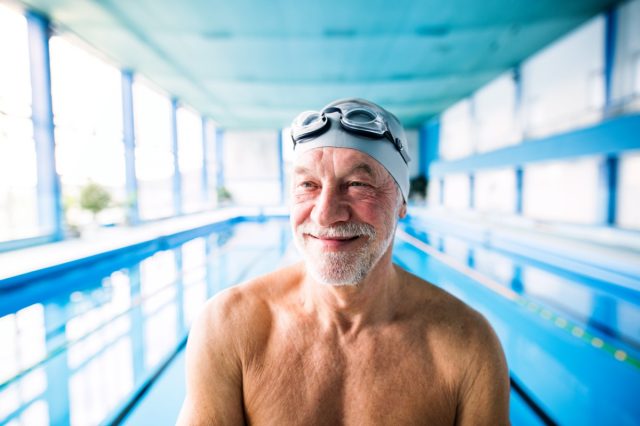
Osteoarthritis is generally a condition that occurs in older individuals. That being said, there’s no reason why you can’t get a jump on stopping leg pain before it has a chance to occur. Consider this research, published in PM&R: Researchers surveyed a group of older participants on their lifelong swimming habits and current levels of osteoarthritis-related knee pain. Sure enough, those who swam with any degree of regularity were less likely to have knee osteoarthritis.
All in all, the study’s authors conclude that swimming early in life (before age 35) appears to be quite beneficial for knee health decades down the line.
Related: This One Exercise Is the Closest Thing to a “Fountain of Youth,” Expert Says
If you have leg pain, avoid these activities
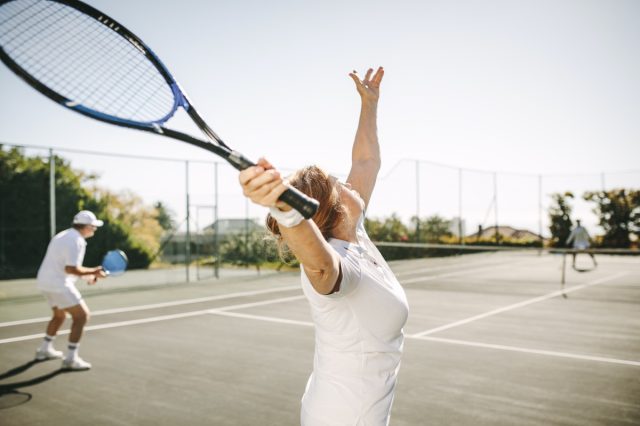
Now that you know that H2O is your friend when it comes to leg pain, you may be wondering which physical activities you should avoid like a bad habit. According to this study, it’s probably a good idea to steer clear of racket sports such as tennis or racquetball. Researchers found that overweight individuals engaging in such activities usually saw their knee osteoarthritis worsen over time.
As far as why this is the case, study authors believe it’s due to all of the high-velocity lateral movements that occur while playing racket sports.
“A large lateral force imparted at the foot during side-to-side movements may be driving large knee adduction moments, a key feature in medial compartment disease, which imparts high compressive loads on the medial tibia and femoral condyle,” explains lead study author Silvia Schirò, M.D., from both the University of California, San Francisco and the University of Parma, Italy. “In support of this premise, the racket sports group showed elevated cartilage degeneration in the medial tibia.”
For more tips to reduce your leg pain, check out these Walking Mistakes That May Be Hurting Your Knees.








